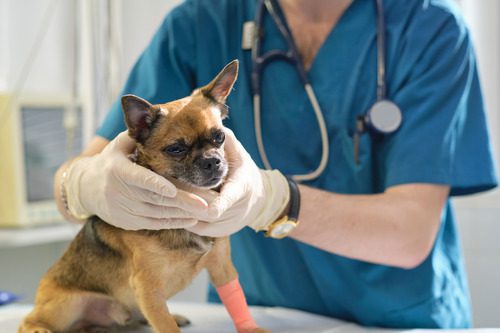Lymphoma in dogs is one of the most common types of cancer affecting canines, and it can appear unexpectedly in dogs of all breeds and ages. While hearing the word “cancer” is understandably overwhelming, learning about lymphoma and the signs to watch for can help you feel more informed and empowered. This blog covers what lymphoma in dogs is, how it presents, how it’s diagnosed, and what steps to take next. At Millis Animal Hospital in Millis, MA, we believe that knowledge is key to helping you make the best decisions for your dog’s health. If you have concerns about lymphoma in dogs, call us at 508-376-5317 or schedule an appointment online.

What Is Lymphoma in Dogs?
Lymphoma in dogs refers to a group of cancers that originate in lymphocytes, which are a type of white blood cell. These cells play a key role in the immune system, so when they become cancerous, the effects can be widespread. Lymphoma often affects the lymph nodes, spleen, liver, bone marrow, and sometimes the gastrointestinal tract. It typically progresses quickly, which is why early detection and veterinary involvement are so important.
There are over 30 different types of lymphoma in dogs, but the most commonly diagnosed form is multicentric lymphoma. This type targets the lymph nodes and is often the first to present visible symptoms. While lymphoma is more frequently seen in middle-aged to older dogs, it can appear in younger dogs as well. Breeds such as Golden Retrievers, Boxers, and Labrador Retrievers may have a higher predisposition.
Common Symptoms of Lymphoma in Dogs
Lymphoma in dogs can manifest in several ways depending on the type and location of the cancer. The most obvious symptom is swollen lymph nodes, which you might notice under your dog’s jaw, in front of their shoulders, or behind their knees. These swellings are often firm and painless.
Other symptoms may include:
- Decreased energy or lethargy
- Weight loss despite a normal appetite
- Loss of appetite
- Increased thirst or urination
- Vomiting or diarrhea
- Difficulty breathing if the chest is affected
Because many of these symptoms are shared with other conditions, a veterinary diagnosis is necessary. If your dog displays any of these signs, especially persistent swollen lymph nodes, contact Millis Animal Hospital at 508-376-5317 to schedule a consultation.
Types of Lymphoma in Dogs
There are several classifications of lymphoma in dogs. Each type impacts different areas of the body and can present with distinct clinical signs.
Multicentric Lymphoma
Multicentric lymphoma is the most common type and typically involves multiple lymph nodes. Dogs may appear otherwise healthy except for enlarged nodes. In some cases, they might also show signs of fatigue, fever, or changes in appetite.
Alimentary Lymphoma
This type affects the gastrointestinal tract. Symptoms include chronic vomiting, diarrhea, weight loss, and a reduced appetite. Because these signs overlap with other digestive issues, diagnostic testing is required to determine the cause.
Mediastinal Lymphoma
Mediastinal lymphoma is less common and affects the lymph nodes or thymus in the chest. Dogs with this type may experience coughing, labored breathing, or swelling in the chest.
Extranodal Lymphoma
Extranodal lymphoma occurs outside the typical lymphatic system and can affect organs such as the skin, eyes, kidneys, lungs, or central nervous system. Symptoms depend heavily on the organ involved. For example, skin involvement may cause raised lesions or ulcers.
Diagnosing Lymphoma in Dogs
Diagnosing lymphoma in dogs starts with a physical exam and a discussion of your dog’s recent health changes. If your veterinarian suspects lymphoma, they may perform a fine needle aspirate to collect a sample of cells from an enlarged lymph node or affected organ. This sample is then examined under a microscope to look for abnormal lymphocytes. In many cases, a biopsy may follow for a more definitive diagnosis. Additional tests may include:
- Bloodwork to evaluate organ function and overall health
- Chest X-rays or abdominal ultrasound to check for internal involvement
- Bone marrow aspiration to assess cancer spread
These steps help determine not only the type of lymphoma but also the stage, which is essential for guiding next steps.
How Lymphoma Is Staged in Dogs
Staging lymphoma helps determine how far the cancer has progressed. This process is similar to cancer staging in humans. The stages include:
- Stage I – Involves a single lymph node
- Stage II – Multiple lymph nodes in a specific region are affected
- Stage III – Generalized lymph node involvement
- Stage IV – Liver and/or spleen are involved
- Stage V – Cancer has spread to the bone marrow, central nervous system, or other organs
Knowing the stage helps your veterinarian provide you with the most appropriate care plan and helps you understand your dog’s condition more clearly.
Lymphoma in Dogs and Life Expectancy
Life expectancy after a lymphoma diagnosis in dogs can vary widely depending on the type, stage, and how early the cancer is detected. Without treatment, dogs with lymphoma typically survive only a few weeks to a couple of months. However, with veterinary-guided care, dogs often experience several months to over a year of good quality of life. Many dogs respond well to veterinary-directed care options, which are designed to improve comfort and manage progression. Each case is different, and the outlook often depends on your dog’s overall health and how the disease is affecting their body.
Can Lymphoma in Dogs Be Prevented?
There is no guaranteed way to prevent lymphoma in dogs. However, maintaining your dog’s overall wellness may support a stronger immune system and help detect illnesses early. Here are some ways to help maintain your pet’s well-being:
- Keeping up with routine wellness visits allows your veterinarian to track any unusual changes, such as swollen lymph nodes or sudden weight loss.
- Some factors, such as breed or genetic predisposition, may be outside your control. However, reducing exposure to environmental toxins, secondhand smoke, and unnecessary chemical exposures may support your dog’s long-term health.
- If you notice any unusual signs or changes in your dog’s behavior, appetite, or energy level, don’t wait—contact Millis Animal Hospital to schedule a checkup.
Partnering with Your Veterinary Team for Next Steps
If your dog has been diagnosed with lymphoma, your veterinarian is your most important resource. They can help you understand the diagnosis, explore available options, and support you in making decisions that prioritize your dog’s quality of life. Every dog and every case of lymphoma is unique. Having a team you trust allows you to ask questions, get clear answers, and plan the best path forward. At Millis Animal Hospital, we’re here to provide the care and support your dog needs. If you have questions about lymphoma in dogs or would like to schedule a visit, call us today at 508-376-5317 or book an appointment online.
Recent Posts
About Us
Millis Animal Hospital is a privately owned AAHA-accredited, Cat-Friendly Certified practice staffed with Fear Free Certified professionals. We know a thing or two about treating pets and their families the way they deserve, with excellent preventive care and surgical services tailored to your individual needs.
